
Yerevan is the capital and largest city of Armenia, as well as one of the world's oldest continuously inhabited cities. Situated along the Hrazdan River, Yerevan is the administrative, cultural, and industrial center of the country, as its primate city. It has been the capital since 1918, the fourteenth in the history of Armenia and the seventh located in or around the Ararat Plain. The city also serves as the seat of the Araratian Pontifical Diocese, which is the largest diocese of the Armenian Apostolic Church and one of the oldest dioceses in the world.

Three Crowns is the national emblem of Sweden, present in the coat of arms of Sweden, and composed of three yellow or gilded coronets ordered two above and one below, placed on a blue background. Similar designs are found on a number of other coats of arms or flags.

The national flag of Armenia, also known as the Tricolour, consists of three horizontal bands of equal width, red on the top, blue in the middle, and orange on the bottom. The Armenian Supreme Soviet adopted the current flag on 24 August 1990. On 15 June 2006, the Law on the National Flag of Armenia, governing its usage, was passed by the National Assembly of Armenia.
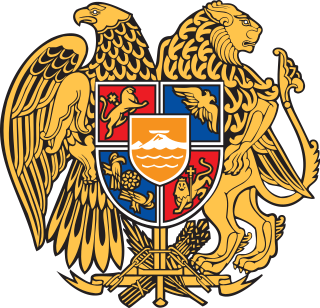
The national coat of arms of Armenia was adopted on April 19, 1992, by resolution of the Armenian Supreme Council. On June 15, 2006, the Armenian Parliament passed the law on the state coat of arms of Armenia.

The coat of arms of Ukraine is a blue shield with a golden trident. It is colloquially known as the tryzub.

The coat of arms of Estonia is a golden shield which includes a picture of three left-facing blue lions with red tongues in the middle, with golden oak branches placed on both sides of the shield. The insignia derive(s) from the coat of arms of Denmark, which ruled northern Estonia in the 13th-14th centuries and parts of western Estonia in the 16th-17th century.

The lion is a common charge in heraldry. It traditionally symbolises courage, nobility, royalty, strength, stateliness and valour, because historically the lion has been regarded as the "king of beasts". The lion also carries Judeo-Christian symbolism. The Lion of Judah stands in the coat of arms of Jerusalem. Similar-looking lions can be found elsewhere, such as in the coat of arms of the Swedish royal House of Bjälbo, from there in turn derived into the coat of arms of Finland, formerly belonging to Sweden.
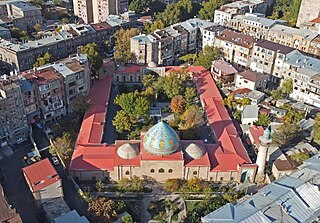
The Blue Mosque is an 18th-century Persian Shia mosque in Yerevan, Armenia. It was commissioned by Hoseyn Ali Khan, the khan of the Iranian Erivan Khanate. It is one of the oldest extant structures in central Yerevan and the most significant structure from the city's Iranian period. It was the largest of the eight mosques of Yerevan in the 19th century and is the only active mosque in Armenia today.

The Yerevan Zoo, also known as the Zoological Garden of Yerevan, is a 35-hectare (86-acre) zoo established in 1940 in Yerevan, Armenia.

Kentron, is one of the 12 districts of Yerevan, the capital of Armenia. It comprises the downtown, the commercial centre of the city. As of the 2011 census, the district has a population of 125,453.
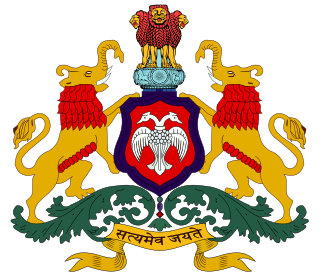
The Emblem of Karnataka is the official state emblem of the State of Karnataka, India. It is based on that of the Kingdom of Mysore, and is carried on all official correspondences made by the Government of Karnataka.
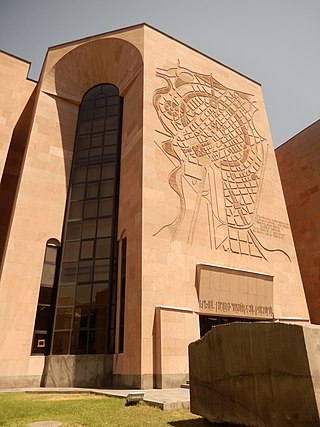
The Yerevan History Museum is the history museum of Yerevan, the capital city of Armenia. The museum was founded in 1931 as the Communal Museum. Currently, the museum is located in a building attached to the Yerevan City Hall. The architect of the building was Jim Torosyan.

The Emblem of Ethiopia has been in its current form since 1996. It contains a yellow interlaced pentagram radiating rays of light on a blue shield. Today, the pentagram stands for the unity of the people and nationality of the Federal Democratic Republic of Ethiopia. The Emblem appears in the centre of the flag of Ethiopia.

The Armenian Hockey League (AHL) is the highest level of ice hockey competition in Armenia. The league was founded in 2000 and currently consists of five teams: Yerevan Lions, Sharks, Pyunik, Peppers, and Falcons.

The Armenian eternity sign or Arevakhach is an ancient Armenian national symbol and a symbol of the national identity of the Armenian people. It is one of the most common symbols in Armenian architecture, carved on khachkars and on walls of churches.

Ani Plaza Hotel, is a 4-star hotel at the central Kentron District of Yerevan, Armenia. It was opened in 1970 as a state-owned enterprise during the Soviet period. After the collapse of the USSR, Ani Hotel was privatized in 1998, and after a major renovation it was reopened as Ani Plaza Hotel in 1999. It is named after the medieval Armenian city of Ani, one of the historical capitals of the Armenian nation.
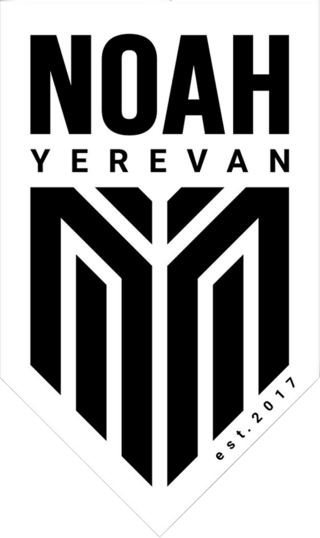
Football Club Noah, commonly known as Noah, is an Armenian professional football club based in Armavir. Founded in 2017 as FC Artsakh, they currently play in the Armenian Premier League.

Yerevan 2800th Anniversary Park, also known as the Vardanyan's park, was opened on 10 May 2019. The park is a gift from Mikayel and Karen Vardanyan on the 2800th anniversary of the foundation of Yerevan city.
The 2019–20 Armenian Premier League season was the 28th since its establishment.

The coat of arms that serves as the symbol of the city of Szczecin in West Pomeranian Voivodeship, Poland depicts the head of a red griffin with a yellow (golden) beak wearing a yellow (golden) crown, placed on the blue background.



















